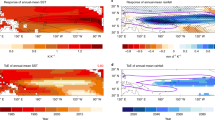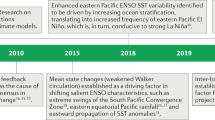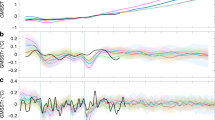Abstract
El Niño/Southern Oscillation (ENSO) sea surface temperature (SST) variability increased after 1960, influenced by more frequent strong El Niño and La Niña events. Whether such changes are linked to anthropogenic warming, however, is largely unknown. In this Perspective, we consider anthropogenic impacts on ENSO variability in several commonly used modelling designs, which collectively suggest a greenhouse warming-related effect on post-1960 ENSO SST variability. Specifically, a comparison of simulated ENSO SST variability between 1901–1960 and 1961–2020 indicates that more than three quarters of climate models produce an amplitude increase in post-1960 ENSO SST variability, translating into more frequent strong El Niño and La Niña events. Multiple large ensemble experiments further confirm that the simulated post-1960 ENSO amplitude increase (approximately 10%) is not solely due to internal variability. Moreover, multicentury-long simulations under a constant pre-industrial CO2 level suggest that the observed post-1960 ENSO variability is high, sitting in the highest 2.5 and 10 percentiles for eastern Pacific and central Pacific ENSO, respectively. Improvement in model ENSO physics, identification of consistent future and historical change in additional ENSO characteristics and single-forcing large-ensemble experiments are further needed to ascertain climate change impacts on the ENSO.
This is a preview of subscription content, access via your institution
Access options
Access Nature and 54 other Nature Portfolio journals
Get Nature+, our best-value online-access subscription
$29.99 / 30 days
cancel any time
Subscribe to this journal
Receive 12 digital issues and online access to articles
$99.00 per year
only $8.25 per issue
Buy this article
- Purchase on Springer Link
- Instant access to full article PDF
Prices may be subject to local taxes which are calculated during checkout






Similar content being viewed by others
Data availability
Data relevant to the paper can be downloaded from 20CR v2c at https://portal.nersc.gov/project/20C_Reanalysis/; CERA-20C at https://apps.ecmwf.int/datsets/dat/cera20c-edmo/levtype=sfc/type=an/; ERA-20C at https://apps.ecmwf.int/datsets/data/era20c-moda/levtype=sfc/type=an/; ERSST v3b at https://www.esrl.noaa.gov/psd/data/gridded/data.noaa.ersst.v3.html; HadISST v1.1 at https://www.esrl.noaa.gov/psd/data/gridded/data.hadsst.html; COBE at https://psl.noaa.gov/data/gridded/data.cobe.html; ORA-s3 at http://apdrc.soest.hawaii.edu/datadoc/ecmwf_oras3.php; ORA-s4 at https://climatedataguide.ucar.edu/climate-data/oras4-ecmwf-ocean-reanalysis-and-derived-ocean-heat-content and 111 CMIP6 database at https://esgf-node.llnl.gov/projects/cmip6/.
Code availability
Codes for calculating EOF can be downloaded from: https://drive.google.com/open?id=1d2R8wKpFNW-vMIfoJsbqIGPIBd9Z_8rj.
References
Kug, J. S., Jin, F. F. & An, S. I. L. Two types of El Niño events: cold tongue El Niño and warm pool El Niño. J. Clim. 22, 1499–1515 (2009).
Kao, H. Y. & Yu, J. Y. Contrasting eastern-Pacific and central-Pacific types of ENSO. J. Clim. 22, 615–632 (2009).
Takahashi, K., Montecinos, A., Goubanova, K. & Dewitte, B. ENSO regimes: reinterpreting the canonical and Modoki El Niño. Geophys. Res. Lett. 38, L10704 (2011).
Takahashi, K. & Dewitte, B. Strong and moderate nonlinear El Niño regimes. Clim. Dyn. 46, 1627–1645 (2016).
Capotondi, A. et al. Understanding ENSO diversity. Bull. Am. Meteorol. Soc. 96, 921–938 (2015).
Lengaigne, M. & Vecchi, G. A. Contrasting the termination of moderate and extreme El Niño events in coupled general circulation models. Clim. Dyn. 35, 299–313 (2010).
Ropelewski, C. F. & Halpert, M. S. Global and regional scale precipitation patterns associated with the El Niño/Southern oscillation. Mon. Weather Rev. 115, 1606–1626 (1987).
Bove, M. C., Eisner, J. B., Landsea, C. W., Niu, X. & O’Brien, J. J. Effect of El Niño on U.S. landfalling hurricanes, revisited. Bull. Am. Meteorol. Soc. 79, 2477–2482 (1998).
Bell, G. D. et al. Climate assessment for 1998. Bull. Am. Meteorol. Soc. 80, 1040 (1999).
McPhaden, M. J., Zebiak, S. E. & Glantz, M. H. ENSO as an integrating concept in earth science. Science 314, 1740–1745 (2006).
Cai, W. et al. Climate impacts of the El Niño-Southern oscillation on South America. Nat. Rev. Earth Environ. 1, 215–231 (2020).
Cai, W. et al. Increasing frequency of extreme El Niño events due to greenhouse warming. Nat. Clim. Change 4, 111–116 (2014).
Vincent, E. M. et al. Interannual variability of the South Pacific convergence zone and implications for tropical cyclone genesis. Clim. Dyn. 36, 1881–1896 (2011).
Cai, W. et al. More extreme swings of the South Pacific convergence zone due to greenhouse warming. Nature 488, 365–369 (2012).
Wang, G. et al. Future Southern ocean warming linked to projected ENSO variability. Nat. Clim. Change 12, 649–654 (2022).
Cai, W. et al. Antarctic shelf ocean warming and sea ice melt affected by projected El Niño changes. Nat. Clim. Change 13, 235–239 (2023).
Li, X. et al. Tropical teleconnection impacts on Antarctic climate changes. Nat. Rev. Earth Environ. 2, 680–698 (2021).
Zhang, Q., Guan, Y. & Yang, H. ENSO amplitude change in observation and coupled models. Adv. Atmos. Sci. 25, 361–366 (2008).
Kim, S. T. et al. Response of El Niño sea surface temperature variability to greenhouse warming. Nat. Clim. Change 4, 786–790 (2014).
Cai, W. et al. Changing El Niño-Southern oscillation in a warming climate. Nat. Rev. Earth Environ. 2, 628–644 (2021).
Grothe, P. R. et al. Enhanced El Niño-Southern oscillation variability in recent decades. Geophys. Res. Lett. 47, e2019GL083906 (2020).
McGregor, S., Timmermann, A. & Timm, O. A unified proxy for ENSO and PDO variability since 1650. Clim. Past 6, 1–17 (2010).
McGregor, S., Timmermann, A., England, M. H., Elison Timm, O. & Wittenberg, A. T. Inferred changes in El Niño-Southern oscillation variance over the past six centuries. Clim. Past 9, 2269–2284 (2013).
Cobb, K. M. et al. Highly variable El Niño-Southern oscillation throughout the holocene. Science 339, 67–70 (2013).
Karamperidou, C. et al. ENSO in a changing climate: challenges, paleo-perspectives, and outlook. in El Niño Southern Oscillation in a Changing Climate (eds McPhaden, M. J., Santoso, A. & Cai, W.) (AGU Monograph, 2020).
Liu, Y. et al. Recent enhancement of central Pacific El Niño variability relative to last eight centuries. Nat. Commun. 8, 15386 (2017).
Freund, M. et al. Higher frequency of Central Pacific El Niño events in recent decades relative to past centuries. Nat. Geosci. 12, 450–455 (2019).
Collins, M. et al. The impact of global warming on the tropical Pacific ocean and El Niño. Nat. Geosci. 3, 391–397 (2010).
DiNezio, P. N. et al. Mean climate controls on the simulated response of ENSO to increasing greenhouse gases. J. Clim. 25, 7399–7420 (2012).
Dommenget, D. & Vijayeta, A. Simulated future changes in ENSO dynamics in the framework of the linear recharge oscillator model. Clim. Dyn. 53, 4233–4248 (2019).
Stevenson, S. et al. Will there be a significant change to El Niño in the twenty-first century? J. Clim. 25, 2129–2145 (2012).
Beobide-Arsuaga, G., Bayr, T., Reintges, A. & Latif, M. Uncertainty of ENSO-amplitude projections in CMIP5 and CMIP6 models. Clim. Dyn. 56, 3875–3888 (2021).
Zheng, X. T., Hui, C. & Yeh, S. W. Response of ENSO amplitude to global warming in CESM large ensemble: uncertainty due to internal variability. Clim. Dyn. 50, 4019–4035 (2018).
Maher, N., Matei, D., Milinski, S. & Marotzke, J. ENSO change in climate projections: forced response or internal variability? Geophys. Res. Lett. 45, 390–398 (2018).
Gan, R., Liu, Q., Huang, G., Hu, K. & Li, X. Greenhouse warming and internal variability increase extreme and central Pacific El Niño frequency since 1980. Nat. Commun. 14, 394 (2023).
Eyring, V. et al. Overview of the Coupled Model Intercomparison Project Phase 6 (CMIP6) experimental design and organization. Geosci. Model. Dev. 9, 1937–1958 (2016).
Cai, W. et al. Increased frequency of extreme La Niña events under greenhouse warming. Nat. Clim. Change 5, 132–137 (2015).
Cai, W. et al. ENSO and greenhouse warming. Nat. Clim. Change 5, 849–859 (2015).
Cai, W. et al. Increased ENSO sea surface temperature variability under four IPCC emission scenarios. Nat. Clim. Change 12, 228–231 (2022).
Kennedy, J. J. A review of uncertainty in in situ measurements and data sets of sea surface temperature. Rev. Geophys. 52, 1–32 (2014).
Gagan, M. K. Paleo-El Niño-Southern Oscillation (ENSO) Records. in Encyclopedia of Palaeoclimatology and Ancient Environments 721–728 (Springer, 2009).
IPCC Climate Change: The Physical Science Basis (eds Masson-Delmotte, V. et al.) (Cambridge Univ. Press, 2021).
Geng, T. et al. Emergence of changing Central-Pacific and Eastern-Pacific El Niño-Southern Oscillation in a warming climate. Nat. Commun. 13, 6616 (2022).
Santoso, A. et al. Late-twentieth-century emergence of the El Niño propagation asymmetry and future projections. Nature 504, 126 (2013).
Power, S. B., Delage, F., Chung, C., Kociuba, G. & Keay, K. Robust twenty-first century projections of El Niño and related precipitation variability. Nature 502, 541–545 (2013).
Wang, G. et al. Continued increase of extreme El Niño frequency long after 1.5 oC warming stabilization. Nat. Clim. Change 7, 568–572 (2017).
Brown, J. R. et al. South Pacific convergence zone dynamics, variability and impacts in a changing climate. Nat. Rev. Earth Environ. 1, 530–543 (2020).
Yun, K. S. et al. Increasing ENSO-rainfall variability due to changes in future tropical temperature–rainfall relationship. Commun. Earth Environ. 2, 43 (2021).
McPhaden, M. J., Santoso, A., & Cai, W. (eds) El Niño Southern Oscillation in a Changing Climate Vol. 253 (John Wiley & Sons, 2020).
Cai, W. et al. Increased variability of eastern Pacific El Niño under greenhouse warming. Nature 564, 201–206 (2018).
Taylor, K. E., Stouffer, R. J. & Meehl, G. A. An overview of CMIP5 and the experiment design. Bull. Am. Meteorol. Soc. 93, 485–498 (2012).
Fredriksen, H.-B., Berner, J., Subramanian, A. C. & Capotondi, A. How does El Niño-Southern oscillation change under global warming — a first look at CMIP6. Geophys. Res. Lett. 47, e2020GL090640 (2020).
Wittenberg, A. T. Are historical records sufficient to constrain ENSO simulations? Geophys. Res. Lett. 36, L12702 (2009).
Stevenson, S. L. Significant changes to ENSO strength and impacts in the twenty-first century: results from CMIP5. Geophys. Res. Lett. 39, L17703 (2012).
Ng, B., Cai, W., Cowan, T. & Bi, D. Impacts of low-frequency internal climate variability and greenhouse warming on El Niño-Southern oscillation. J. Clim. 34, 2205–2218 (2021).
Cai, W. et al. Butterfly effect and a self-modulating El Niño response to global warming. Nature 585, 68–73 (2020).
Hawkins, E. & Sutton, R. Time of emergence of climate signals. Geophys. Res. Lett. 39, L01702 (2012).
Deser, C. et al. Insights from Earth system model initial-condition large ensembles and future prospects. Nat. Clim. Change 10, 277–286 (2020).
Deser, C. et al. ENSO and Pacific decadal variability in the Community Climate System Model version 4. J. Clim. 25, 2622–2651 (2012).
Hawkins, E., Smith, R. S., Gregory, J. M. & Stainforth, D. A. Irreducible uncertainty in near-term climate projections. Clim. Dyn. 46, 3807–3819 (2016).
Machete, R. L. & Smith, L. A. Demonstrating the value of larger ensembles in forecasting physical systems. Tellus A Dyn. Meteorol. Oceanogr. 68, 28393 (2016).
Bengtsson, L. & Hodges, K. I. Can an ensemble climate simulation be used to separate climate change signals from internal unforced variability? Clim. Dyn. 52, 3553–3573 (2019).
Ying, J. et al. Emergence of climate change in the tropical Pacific. Nat. Clim. Change 12, 356–364 (2022).
Geng, T., Cai, W. & Wu, L. Two types of ENSO varying in tandem facilitated by nonlinear atmospheric convection. Geophys. Res. Lett. 47, e2020GL088784 (2020).
Geng, T., Cai, W., Wu, L. & Yang, Y. Atmospheric convection dominates genesis of ENSO asymmetry. Geophys. Res. Lett. 46, 8387–8396 (2019).
Zheng, X.-T., Xie, S.-P., Lv, L. H. & Zhou, Z. Q. Intermodel uncertainty in ENSO amplitude change tied to Pacific Ocean warming pattern. J. Clim. 29, 7265–7279 (2016).
Hayashi, M., Jin, F.-F. & Stuecker, M. F. Dynamics for El Niño-La Niña asymmetry constrain equatorial-Pacific warming pattern. Nat. Commun. 11, 4230 (2020).
Ying, J., Huang, P., Lian, T. & Chen, D. Intermodel uncertainty in the change of ENSO’s amplitude under global warming: role of the response of atmospheric circulation to SST anomalies. J. Clim. 32, 369–383 (2019).
Kohyama, T., Hartmann, D. L. & Battisti, D. S. La Niña–like mean-state response to global warming and potential oceanic roles. J. Clim. 30, 4207–4225 (2017).
Carréric, A. et al. Change in strong Eastern Pacific El Niño events dynamics in the warming climate. Clim. Dyn. 54, 901–918 (2020).
Dewitte, B., Yeh, S.-W., Moon, B.-K., Cibot, C. & Terray, L. Rectification of the ENSO variability by interdecadal changes in the equatorial background mean state in a CGCM simulation. J. Clim. 20, 2002–2021 (2007).
Thual, S., Dewitte, B., An, S.-I. & Ayoub, N. Sensitivity of ENSO to stratification in a recharge–discharge conceptual model. J. Clim. 4, 4331–4348 (2011).
Jia, F., Cai, W., Gan, B., Wu, L. & Di Lorenzo, E. Enhanced north Pacific impact on El Niño/Southern Oscillation under greenhouse warming. Nat. Clim. Change 11, 840–847 (2021).
Balmaseda, M. A., Vidard, A. & Anderson, D. L. T. The ECMWF ocean analysis system: ORA-S3. Mon. Weath Rev. 136, 3018–3034 (2008).
Balmaseda, M. A., Mogensen, K. & Weaver, A. T. Evaluation of the ECMWF ocean reanalysis system ORAS4. Q. J. R. Meteorol. Soc. 139, 1132–1161 (2013).
Jin, F.-F. An equatorial ocean recharge paradigm for ENSO. Part I: conceptual model. J. Atmos. Sci. 54, 811–829 (1997).
Fang, X. & Mu, M. A three-region conceptual model for central Pacific El Niño including zonal advective feedback. J. Clim. 31, 4965–4979 (2018).
Chen, N., Fang, X. & Yu, J. Y. A multiscale model for El Niño complexity. npj Clim. Atmos. Sci. 5, 16 (2022).
Fang, X. & Chen, N. Quantifying the predictability of ENSO complexity using a statistically accurate multiscale stochastic model and information theory. J. Clim. 36, 2681–2702 (2023).
IPCC Climate Change 2013: The Physical Science Basis. Contribution of Working Group I to the Fifth Assessment Report of the Intergovernmental Panel on Climate Change (eds Stocker, T. F. et al.) 1535 pp. (Cambridge Univ. Press, 2013).
Hoesly, R. M. et al. Historical (1750–2014) anthropogenic emissions of reactive gases and aerosols from the Community Emissions Data System (CEDS). Geosci. Model. Dev. 11, 369–408 (2018).
Emile-Geay, J. et al. Past ENSO variability: reconstructions, models, and implications. In El Niño Southern Oscillation in a Changing Climate (eds McPhaden, M. J., Santoso, A. & Cai, W.) (AGU Monograph, 2020).
Carre, M., Sachs, J. P., Schauer, A. J., Rodriguez, W. E. & Ramos, F. C. Reconstructing El Niño‐Southern oscillation activity and ocean temperature seasonality from short‐lived marine mollusk shells from Peru. Palaeogeogr. Palaeoclimatol. Palaeoecol. 371, 45–53 (2013).
Rein, B. How do the 1982/83 and 1997/98 El Niño’s rank in a geological record from Peru? Quat. Int. 161, 56–66 (2007).
Frappier, A., Sahagian, D., Gonzalez, L. A. & Carpenter, S. J. El Niño events recorded by stalagmite carbon isotopes. Science 298, 565–565 (2002).
Maher, N. et al. The future of the El Niño-Southern oscillation: using large ensembles to illuminate time-varying responses and inter-model differences. Earth Syst. Dyn. Discuss https://doi.org/10.5194/esd-2022-26 (2022).
Bony, S. & Dufresne, J. L. Marine boundary layer clouds at the heart of tropical cloud feedback uncertainties in climate models. Geophys. Res. Lett. 32, L20806 (2005).
Compo, G. P. et al. The twentieth century reanalysis project. Q. J. R. Meteorol. Soc. 137, 1–28 (2011).
Laloyaux, P. et al. CERA-20C: a coupled reanalysis of the twentieth century. J. Adv. Model. Earth Syst. 10, 1172–1195 (2018).
Poli, P. et al. ERA-20C: an atmospheric reanalysis of the twentieth century. J. Clim. 29, 4083–4097 (2016).
Smith, T. M., Reynolds, R. W., Peterson, T. C. & Lawrimore, J. Improvements to NOAA’s historical merged land-ocean surface temperature analysis (1880–2006). J. Clim. 21, 2283–2296 (2008).
Rayner, N. A. et al. Global analyses of sea surface temperature, sea ice, and night marine air temperature since the late nineteenth century. J. Geophys. Res. 108, 4407 (2003).
Ishii, M., Shouji, A., Sugimoto, S. & Matsumoto, T. Objective analyses of sea-surface temperature and marine meteorological variables for the 20th century using ICOADS and the Kobe collection. Int. J. Climatol. 25, 865–879 (2005).
Acknowledgements
This project is supported by the Science and Technology Innovation Project of Laoshan Laboratory (LSKJ202203300) and the Strategic Priority Research Programme of Chinese Academy of Sciences (XDB 40030000). T.G. is supported by the National Natural Science Foundation of China (NSFC) project (42206209, 42276006) and China National Postdoctoral Program for Innovative Talents (BX20220279). L.W., X.L. and B.G. are supported by the NSFC projects (41490643, 41490640, U1606402 and 41521091). W.C., G.W., B.N. and A.S. are supported by CSHOR, a joint research Center for Southern Hemisphere Oceans Research between QNLM and CSIRO. A.S., B.N. and G.W. are supported by the Australian Government’s National Environmental Science Program (NESP). M.C. was supported by a grant from the UK Natural Environment Research Council (NE/S004645/1). The authors acknowledge the World Climate Research Programme’s Working Group on Coupled Modelling, which is responsible for CMIP, and the authors thank the climate modelling groups for producing and making available their model output. For CMIP, the US Department of Energy’s Program for Climate Model Diagnosis and Intercomparison provides coordinating support and led development of software infrastructure in partnership with the Global Organization for Earth System Science Portals. The authors are also grateful to various reanalysis groups for making the data sets available to us. PMEL contribution no. 4957.
Author information
Authors and Affiliations
Contributions
W.C. conceived the article and wrote the initial manuscript in discussion with T.G., B.N. and L.W. B.N. and T.G. performed analysis and generated final figures. All authors contributed to interpreting findings, discussion of the associated dynamics and improvement of this paper.
Corresponding authors
Ethics declarations
Competing interests
The authors declare no competing interests.
Peer review
Peer review information
Nature Reviews Earth & Environment thanks Xiang-Hui Fang, Ping Huang and the other, anonymous, reviewer(s) for their contribution to the peer review of this work.
Additional information
Publisher’s note Springer Nature remains neutral with regard to jurisdictional claims in published maps and institutional affiliations.
Supplementary information
Rights and permissions
About this article
Cite this article
Cai, W., Ng, B., Geng, T. et al. Anthropogenic impacts on twentieth-century ENSO variability changes. Nat Rev Earth Environ 4, 407–418 (2023). https://doi.org/10.1038/s43017-023-00427-8
Accepted:
Published:
Issue Date:
DOI: https://doi.org/10.1038/s43017-023-00427-8
This article is cited by
-
Statistical relationships between the Interdecadal Pacific Oscillation and El Niño–Southern Oscillation
Climate Dynamics (2024)
-
Towards improved seasonal rainfall prediction in the tropical Pacific Islands
Theoretical and Applied Climatology (2023)



